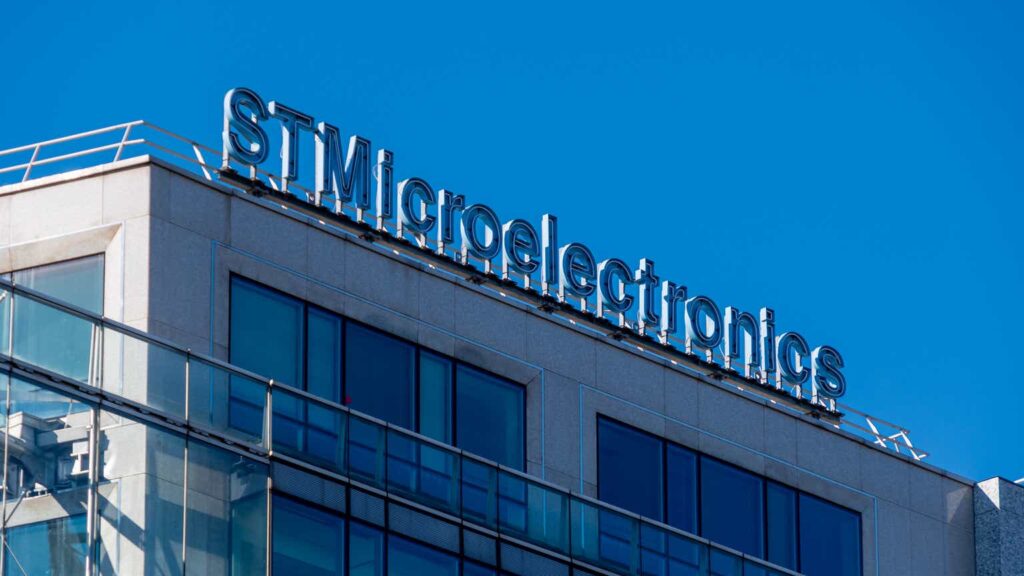Here at the Lab, STMicroelectronics (NYSE:STM) is still a top pick within our EU coverage, and we believe (post Q3 results) limited changes to Wall Street analyst consensus are likely to bring short-term relief to the stock price performance. Indeed, since our last update in Q2, the company share price has declined by 20% (Fig 1). Market sentiment remains pessimistic and questions the automotive earning sustainability. Automotive & Discrete Group sales represent 46% of the company’s turnover. However, our internal team has a positive view of the EU auto industry, confirmed by our buy rating of Volkswagen, Renault, and Stellantis. This is based on 1) deliveries still below pre-COVID-19 outbreaks and 2) the ongoing EV revolution. The new auto will experience more chips compared to ICE cars. Therefore, we have no reason to believe in a segment slowdown.
Mare Past Analysis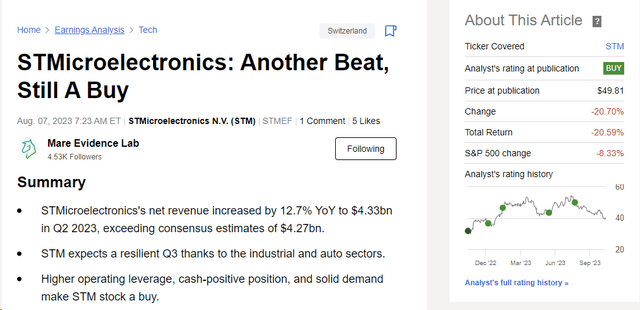
Fig 1
Q3 results
Cross-checking analysts’ expectations, STM’s core operating profit was 4% higher than consensus in Q3 2023, and based on the company’s latest guidance, it is a single-digit below Q4. Looking at the quarter, STM delivered a solid set of results. In numbers, top-line sales reached $4.43 billion with a GM of 47.6% and a core operating margin of 28.0% (Fig 2). The company’s net profits were $1.09 billion, with an EPS of $1.16. Our overweight rating was derived with a 2023 EPS forecast of $4.28. Post Q3 results, we believe the company is well on track to achieve this performance. More importantly, looking at the divisional level, STM growth was driven by the automotive segment, confirmed a 30% growth on a yearly basis, and further accelerated quarterly with a plus 4%. Microcontrollers and Digital were also up by +3% year-on-year, while Analog, MEMS, and Sensors decreased by 28%. A consumer slowdown in the smartphone environment mainly impacted this division. Gross margin was ten basis points higher than consensus on higher utilization rate and better product MIX.
STM Q3 Financials in a Snap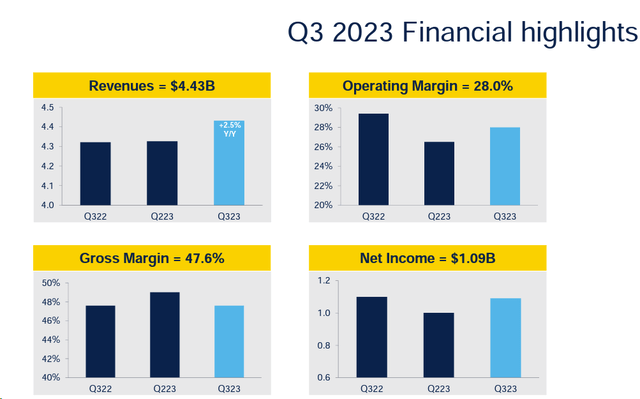
Source: STM Q3 results presentation – Fig 2
Looking ahead, in Q4, the company expects net revenues of $4.3 billion as mid-guidance value, with a decrease of 3% vs. last year’s results. Going down the P&L, the gross margin is expected to be around 46% (+/- 200 basis points). The outlook assumes an exchange rate of $1.08/€1.0 (Fig 3). Therefore, STM full-year sales are now at $17.3 billion, a plus 7% year on year, with a gross margin of around 48.1%.
STM Q4 Guidance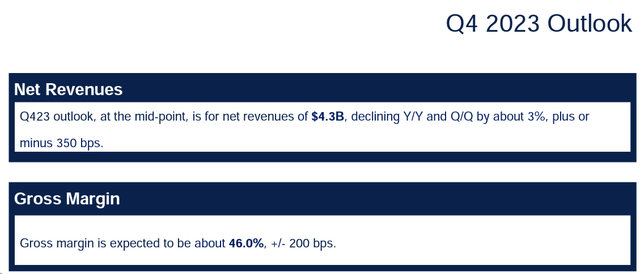
Fig 3
Why are we still positive?
- After a cash dividend of $58 million and a buy-back of $87 million, as of September end, STM’s net financial position was positive (Fig 4) and leaving unchanged the CAPEX plan aligned with the CEO comment, we arrived at the year-end position of $3.2 billion. We believe that capital position flexibility is a plus in this momentum. Here at the Lab, we are forecasting a DPS increase of 5% for 2024; however, there is space for opportunistic M&A and a new CAPEX plan;
-
Related to new investments, STM and Sanan Optoelectronics, a Chinese semiconductor company specializing in LED, signed an agreement to create a manufacturing joint venture to produce SiC carbide devices. The new SiC facility is expected to begin production in Q4 2025. STM aims to support China’s growing demand for automotive electrification, renewable energy, and new power applications. Meanwhile, Sanan will separately build and operate a new 200mm SiC substrate manufacturing plant to meet the needs of the joint venture, using its own SiC substrate manufacturing process. The CAPEX requirements are set at approximately $3.2 billion over the next five years and will be financed by local government support. For STM, this is a crucial step to increase its global SiC manufacturing operations further and is in line with the company’s sales target to achieve $20 billion in sales in 2025-2027. STM is building momentum on SiC initiatives, and in 2023, the company exceeded the first billion in sales within the segment (Fig 6). This is not the first agreement that STM has signed; here at the Lab, we have already reported the new collaboration with Soitec;
- In early October, the company communicated a new silicon carbide facility in Italy for a total investment of €730 million. This new lab will support the EU’s growing demand for SiC devices for automotive and industrial applications. In detail, the plant will be built close to the Catania site and will be the first of its kind to produce 150 mm SiC epitaxial substrates. According to the EU Commission website, STM will take subsidies of approximately €292.5 million.
STM capital structure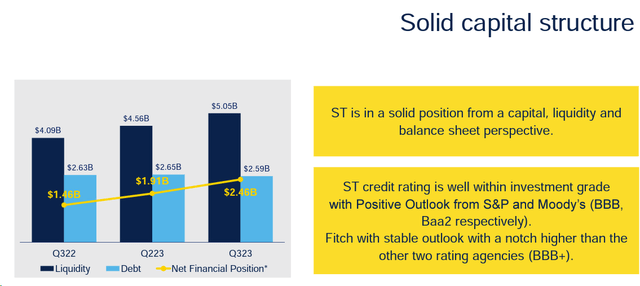
Fig 4
STM FCF
Fig 5
STM SiC upside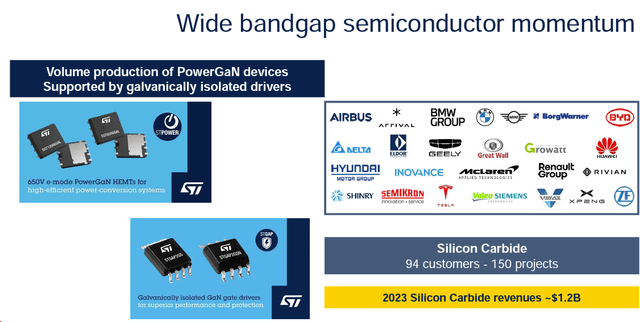
Fig 6
Conclusion and Valuation
Post Q3 results, we have 2023 top-line sales of $17.4 billion with an EBIT of $4.7 billion. Thanks to the latest CAPEX plan, we see an upside in the current valuation, and we confirmed 2025 sales of $20 billion. STM has a mid-single-digit revenue growth estimate (+7%) and support from the EU Union. The Old Continent microchip production is around 9%, and there is a plan to reach 20% worldwide production by 2030. Lower CAPEX, given the EU support and solid profitability across the cycle, leads our numbers to derive a 2024 EPS at 4.57. In addition, the company has a surplus FCF and is already cash-positive. STM trades with an EV/EBITDA of 5.5x and a P/E of 8.5x and is a worldwide company with a clear upside in the EU thanks to a supportive framework. We believe the company will continue to experience strong demand in the automotive and industrial sectors. We are also encouraged by the group’s gross solid margin performance, now forecast at around 46% in Q4 2023. Despite a consumer slowdown, STM continues to manage the cycle well, with growth in automotive and stability in microcontrollers. Looking at the PHLX Semiconductor Sector performance, the index declined by 13%, while STM, which was already discounted, continues to have a higher valuation discrepancy. STM is moving away from Apple, being its biggest client, and is diversifying by products and regions. The company has a solid order backlog, and in our estimates, we arrive at a valuation of €60 per share with a 2023 EPS of $4.28 and an unchanged P/E of 16x. This is also supported by a median EV/EBITDA of 10x and a reverse DCF with a WACC of 9% and a long-term growth rate of 3%. Key macro risk factors are the weakening of the $/€ exchange rate, lower GDP growth rates, and a slowdown in consumer electronics. On the micro risks, we should highlight capacity growth from comps with an imbalance in supply/demand, technology product life cycles (iPhone cycles), and utilization rates.
Editor’s Note: This article discusses one or more securities that do not trade on a major U.S. exchange. Please be aware of the risks associated with these stocks.
Read the full article here


